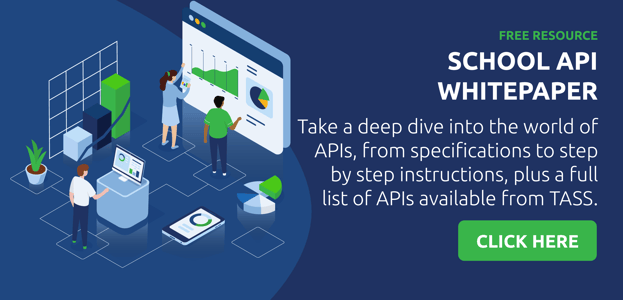Manage every aspect of your school's critical data.

Untangling Your School's Systems with API Integrations
When it comes to organising and integrating the long list of systems that a school has in place, it can be difficult to know whether they can connect, how to connect them, and how the connections already in place are working.
| QUICK LINKS |
Short-term fixes that become long-term headaches are common in these situations, where a single software update can ruin months of painstaking efforts to force a connection between software that doesn’t ‘play nice’ together.
After investing significant time and resources into these custom integrations, schools can end up feeling ‘stuck’ with vendors that no longer fit their needs, and it becomes difficult to know where to start disconnecting or reconnecting software.
If this sounds familiar, or you’ve seen the struggles of your IT team as they balance several different hats – from developer to bug tester and software support – you may be wondering why there isn’t an easier way to connect your school’s systems.
Well… there is: API Connections.
TASS has had a publicly available API Program in place since 2017, so we have quite a bit of experience in what API connections can offer schools in terms of security, convenience, and reliability.
We’ve outlined some of the key advantages below, but before we discuss how APIs could help, it’s important to know how they work.
What are APIs?
An API (Application Programming Interface) is a kind of predetermined access point that other systems can use to interact with set information and data, allowing different programs to talk to each other without the need for a direct database connection.
You can imagine an API as a server at a restaurant – they give you a menu of food items, you give them your order, and they deliver your meal to your table.
In this scenario, the kitchen is your database - home to the extensive, often sensitive information from around your school.
APIs allow your other systems to order approved information from your database, without giving everyone free reign of the kitchen.
This allows chefs to focus on cooking, keeps customers safely out of the kitchen, and ensures the right food goes to the right people.
TASS has APIs for a range of different needs, from Student Analytics to LMS integrations and General Ledger information.
These APIs can be used to build custom reports or integrate with your school’s other systems - or you can use pre-built Certified Integrations from one of our Integration Partners. It’s your data to use how you want to use it.
API Benefits
It’s highly likely that your school already has some connections or integrations in place between your various systems. How well these work together will likely vary depending on the support given by vendors and the programming skills and time available from your IT team.
Performance
If your school is building connections from scratch every time you need to link a new system, you can end up with a jungle of tangled connections and integrations.
The resulting code can often end up functional but poorly optimised, which is potentially detrimental to the performance of your school’s core systems.
Whether they’re built by third-party providers or pieced together in-house, typically few fully understand how these integrations work, and even fewer understand how to fix them if something goes wrong.
APIs offer a clear, well-documented recipe for how connections work, making them easier to use and maintain.
Built and supported by in-house developers, TASS’ APIs are designed to optimise connections, so that system performance isn’t negatively affected by the other software being linked.
Reliability
Often one of the major problems with direct database connections isn’t apparent until they’re already in place. These connections are not backwards compatible and do not get updated automatically if something changes in one of the systems they’re connecting.
This means that any software update can risk ‘exploding’ connections to other systems. Schools then have to dedicate even more time and resources to patching holes and fixing issues with integrations that are not supported by the software they’re connecting.
The result is that schools will often delay software updates until absolutely essential, which leaves you missing out on new features or enhancements – not to mention vital security updates and bug fixes.
They also act as an additional layer in between each system, which means that integrated software can be used and updated without the stress of fixing broken connections.
Cloud Hosting
After the last couple of years, it’s safe to say that basically everyone can appreciate the importance of software solutions that just work, no matter where you’re working from.
This is true whether your school was able to switch seamlessly to online learning, or whether there was a frantic behind the scenes scramble to get things up and running for your staff and students.
We’ve previously spoken about the benefits of Cloud Hosting solutions, but it may not be as easy for schools with a tonne of direct database connections to make the switch.
APIs allow schools to connect to their data regardless of what environment they’re in, so that they’re no longer restricted to just on-premises hosting options.
This opens the door to a range of cost savings, security measures and performance improvements that aren’t available to schools that are stuck with on-premises hosting as a necessity, rather than by choice.
Flexibility
Picture living in a house with no power points, where every appliance and electrical device has to be connected directly to your power supply. Would you upgrade an old, outdated appliance if it meant having to rewire your house?
Direct database connections are a similar situation, where heavily customised integrations that are ‘hardwired’ into the database can create issues when schools want to change systems.
Whether it’s your Learning Management System, HR software or entire School Information System, it can be difficult to even know where to start disconnecting or reconnecting things.
Switching then becomes a costly and time-consuming process, which can leave schools ‘stuck’ with vendors that no longer fit their needs.
With a lot of time and money invested in these systems and integrations, Schools can also fall prey to the “sunk cost effect” – an economics concept and logical fallacy that applies when a business continues to commit to something purely because they cannot recover the resources already invested in the project or activity.
When schools do switch systems, but try to keep the same web of integrations, project teams are met with roadblock after roadblock as they try to untangle and reconnect a suite of custom connections that have been growing more complicated with every software update.
Offering a convenient plug-and-play set up, APIs help to future-proof your school’s connections with standard structures and set end-points that take the guesswork out of integrating and reduce the difficulty of switching or introducing systems.
Privacy and Security
Schools collect and use a vast array of data, from financial records to medical history and socioeconomic information.
Given the extensive and sensitive data being stored, unwanted access, access to too much information, and potential data breaches are major concerns for any school.
Direct database connections are undeniably useful if there’s no alternative, but with no way to actively monitor the connections, they leave a school’s database open to a range of potential attacks, presenting a significant data security risk.
Privacy concerns should also be considered when sharing your school’s information with third parties, as giving vendors direct access to your school’s data will often expose much more information than a single provider would typically need.
Rigorously tested, encrypted API connections, such as those available from TASS, add a layer of security that’s not possible with direct database connections, protecting data from potential attacks and recording connections in an accessible audit log.
TASS APIs also allow schools to turn connections on or off as needed, with granular security permissions that give schools complete control over what data can be accessed by which systems.
Data Integrity
Even without the risk of external threats, any direct path to and from a database is an opportunity for something to go wrong.
With every system handling data differently, it can be hard to ensure that the correct and most relevant information is being collected or pushed, without anything getting lost in translation.
Whether it’s data being accidentally rewritten or the wrong records being modified, even small or well-meaning changes can have huge ramifications.
This can cause issues when your connected systems don’t have a detailed understanding of the data relationships and validations of your school’s database.
Seeing information in the front-end part of a system is very different to the barebones view provided in the backend database, and what might look like a simple connection can easily get misinterpreted when looking at the information with no context.
A common example of this is family structures, where it can be easy to misinterpret how parents and students are connected. A system may import both parents’ contact details by default, but not know to also carry over a specific communication rule or limitation in place due to a potentially complex family situation.
Sending communication to parents and carers through this system could therefore cause major issues for your school if the wrong parent is contacted or restricted information is shared.
APIs take the guesswork out of this development process, as they’re planned, tested, documented and published by the same people who build the software, keeping the specific database structure in mind.
If you would like to learn more about the use of APIs in schools, including a technical background, an in-depth look at TASS APIs, step-by-step instructions, and a full list of the APIs available from TASS, download our School API Whitepaper below.



